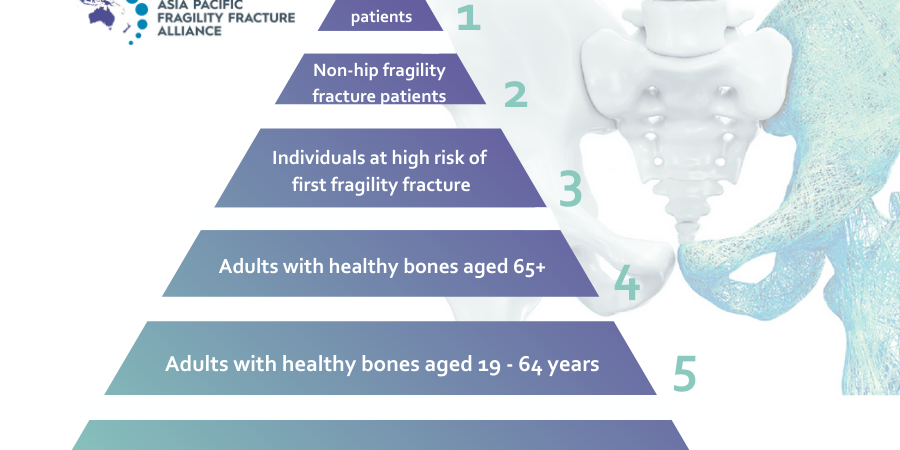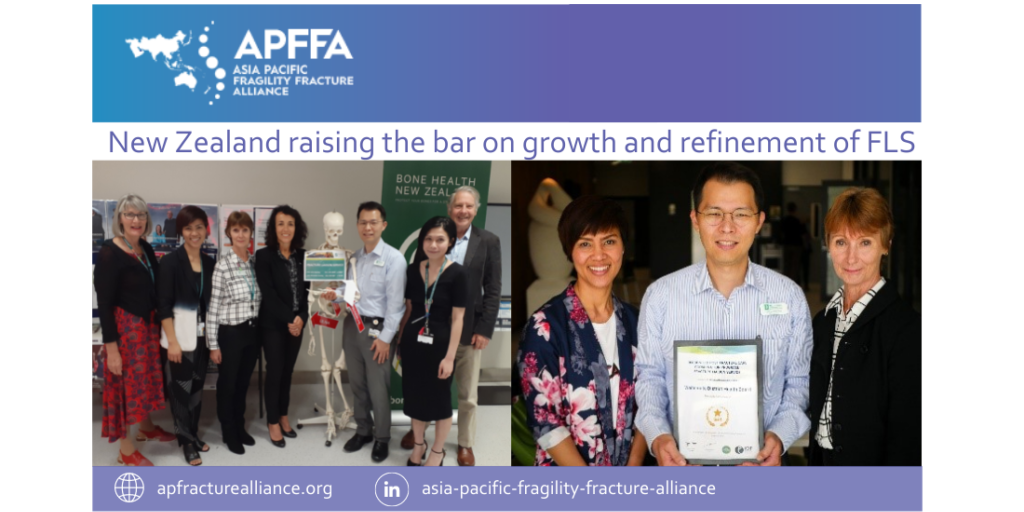Despite increasing awareness of the concept ‘Fracture begets fracture’, there is often little-follow up for post fracture management following the acute management of a fracture. To address this, two of APFFA’s member organisations – the International Osteoporosis Foundation (IOF) and the Asia Pacific Orthopaedic Association (APOA) – have recently joined forces to launch a new publication titled ‘Closing the Gap Between Orthopaedic Surgeons and Physicians in Secondary Fracture Prevention: A Call to Action’. The publication calls on orthopaedic surgeons to strengthen collaboration with physicians (across all disciplines), and play a greater role in the post-fracture management of patients living with osteoporosis.
The new publication outlines the epidemiology of osteoporosis and fragility fractures in the Asia Pacific region, and features 12 key messages pertaining to fracture management, post-fracture rehabilitation, fracture healing and the development of national fracture registries.
Most importantly, the publication highlights the following 10 urgent actions which should be considered by the medical community, particularly orthopaedic surgeons:
- Recognise that the burden of osteoporosis and related fragility fractures has substantially increased, and will continue to increase markedly in the future in the Asia Pacific region.
- Recognise that osteoporosis is a disease that remains under-diagnosed and undertreated, and work towards increased awareness of the disease, and the need for fracture prevention among medical practitioners and the public.
- Physicians and orthopaedic surgeons should work together to ensure effective management of the disease, including early diagnosis, fracture risk assessment, early and appropriate pharmacological treatment and monitoring, and fracture prevention (both primary and secondary).
- Physicians should recognise the importance of appropriate fracture fixation, post- fracture rehabilitation and care, to allow patients to achieve maximum functional recovery.
- Orthopaedic surgeons should recognise the challenge in fragility fracture management, particularly surgical treatment of these fractures.
- Orthopaedic surgeons must always equip themselves to fix fractures in the best way possible, with proper pre-operative planning, selection of the appropriate implants and approach, and with the possible use of augmentation to promote fracture healing.
- Orthopaedic surgeons should perform risk assessment, appropriate pharmacological management and treatment monitoring to promote compliance and adherence, and provide proper rehabilitative care to prevent subsequent fractures.
- Orthopaedic surgeons must be equipped with the necessary knowledge, interest and confidence in initiating and continuing pharmacological treatments for osteoporosis.
- Promote orthogeriatric care and services in combination with occupational and physiotherapists in handling elderly with fragility fractures presenting with concomitant dementia.
- Orthopaedic surgeons are encouraged to take a leading role in the development and implementation of Fracture Liaison Services or Orthogeriatric Services in their hospitals and clinics.
According to APFFA Co-Chair and Chair of the IOF Regional Advisory Council for the Asia Pacific, Dato’ Dr Joon-Kiong Lee, Malaysia, in our region, as in other parts of the world, there is a ‘missing link’ between the various medical experts who manage osteoporosis patients, and the orthopaedic surgeons who see fragility fracture patients in their daily practice.
“The new IOF-APOA initiative provides a platform to increase awareness and collaborative efforts between the orthopaedic surgeons and the various physicians involved.
“We intend to generate both the interest and confidence required to effectively manage osteoporosis and fragility fractures, as a team effort,” said Dato’ Dr Lee.
IOF President, Professor Cyrus Cooper, UK, reinforced the importance of IOF’s collaboration with APOA and the orthopaedic community, stating:
“We hope this initiative, arising from close international collaboration between IOF and colleagues in APOA, will lead to concerted efforts by all orthopaedic surgeons to work hand-in-hand with medical organisations and healthcare authorities across the region, to improve post-fracture care.
“If widely implemented, the key actions outlined in the IOF-APOA ‘Call to Action’ will certainly result in improved patient outcomes, and ultimately, in a reduction in the region’s fracture burden,” Prof Cooper said,
To view and download the full publication, click here.





